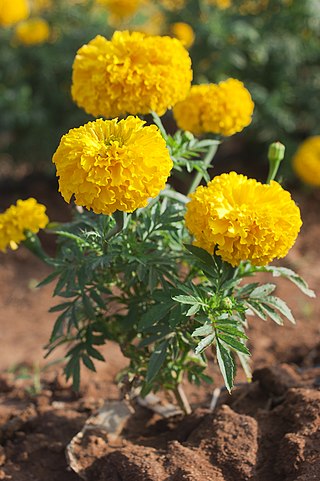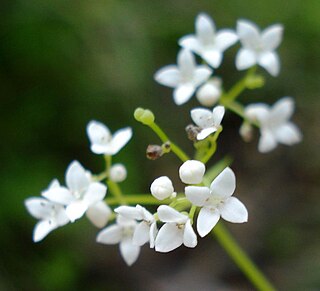
Yucca is a genus of perennial shrubs and trees in the family Asparagaceae, subfamily Agavoideae. Its 40–50 species are notable for their rosettes of evergreen, tough, sword-shaped leaves and large terminal panicles of white or whitish flowers. They are native to the Americas and the Caribbean in a wide range of habitats, from humid rainforest and wet subtropical ecosystems to the hot and dry (arid) deserts and savanna.

Tagetes is a genus of 50 species of annual or perennial, mostly herbaceous plants in the family Asteraceae. They are among several groups of plants known in English as marigolds. The genus Tagetes was described by Carl Linnaeus in 1753.

Anodonta is a genus of freshwater mussels in the family Unionidae, the river mussels.

Rubieae is a tribe of flowering plants in the family Rubiaceae and contains 970 species in 15 genera. The genus Galium is responsible for more than two thirds of the species in the tribe. The second largest genus is Asperula, which contains about 200 species. Unlike the rest of the family Rubiaceae, the tribe contains predominantly perennial and annual herbs with pseudowhorls of leaves and leaflike stipules and is centered in temperate and tropical-mountain regions.

Agave is a genus of monocots native to the arid regions of the Americas. The genus is primarily known for its succulent and xerophytic species that typically form large rosettes of strong, fleshy leaves. Agave now includes species formerly placed in a number of other genera, such as Manfreda, ×Mangave, Polianthes and Prochnyanthes.
Acheilognathus microphysa is a species of ray-finned fish in the genus Acheilognathus. It is endemic to China.
Schistura cataracta is a species of ray-finned fish in the stone loach genus Schistura. It occurs in the Nam Theun and Nam Gnouang, in the Mekong basin of Laos. It prefers stretches of rivers with fast current and a stony or rocky substrate, but it does occasionally occur over gravel or sandy substrates. It can also be found in reservoirs, albeit at low densities and dams are the biggest threat to this species.
Triplophysa microphysa is a species of ray-finned fish in the genus Triplophysa.

Pyganodon cataracta, formerly Anodonta cataracta, is a species of large freshwater mussel, an aquatic bivalve mollusc in the family Unionidae, the river mussels. Its common name is the eastern floater.
Trymalitis cataracta is a species of moth of the family Tortricidae first described by Edward Meyrick in 1907. It is found in Sri Lanka, Australia, New Guinea, Bismarck Archipelago, Caroline Islands, Fiji, Java, Siam, Andaman Islands, Africa and Madagascar.
Eugnosta cataracta is a species of moth of the family Tortricidae. It is found in Namibia.

In biology, being semiaquatic refers to various macroorganisms that live regularly in both aquatic and terrestrial environments. When referring to animals, the term describes those that actively spend part of their daily time in water, or land animals that have spent at least one life stages in aquatic environments. When referring to plants, the term describes land plants whose roots have adapted well to tolerate regular, prolonged submersion in water, as well as emergent and (occasionally) floating-leaved aquatic plants that are only partially immersed in water.

The Solanaceae, or the nightshades, are a family of flowering plants that ranges from annual and perennial herbs to vines, lianas, epiphytes, shrubs, and trees, and includes a number of agricultural crops, medicinal plants, spices, weeds, and ornamentals. Many members of the family contain potent alkaloids, and some are highly toxic, but many—including tomatoes, potatoes, eggplant, bell and chili peppers—are used as food. The family belongs to the order Solanales, in the asterid group and class Magnoliopsida (dicotyledons). The Solanaceae consists of about 98 genera and some 2,700 species, with a great diversity of habitats, morphology and ecology.

Scolopendra cataracta is a species of centipede in the family Scolopendridae. It is the first known amphibious centipede, growing to up to 20 centimetres (7.9 in) in length.
S. cataracta could refer to one of the following species:

Idaea microphysa is a species of geometrid moth in the family Geometridae. It is found in North America.
Aborichthys cataracta is a species of stone loach endemic to streams joining Ranga River in Upper Subanshri District, India. This fish grows to a length of 9.3 centimetres (3.7 in) SL.

Psoralea cataracta is a species of flowering plant in the family Fabaceae. It was declared extinct in 2008 in the Red List of South African Plants, with a single specimen collected from the Tulbagh Waterfall in 1804. It was rediscovered 200 years later by Brian Du Preez in November of 2019 in the Winterhoek Mountains near Tulbagh. It is endemic to the Western Cape. It is also known by the name waterfall fountainbush.
Microphysa elongata is a species of flowering plant in family Rubiaceae. It is a perennial native to Kazakhstan, Kyrgyzstan, Uzbekistan, and Xinjiang in Central Asia. It is the sole species in genus Microphysa.










